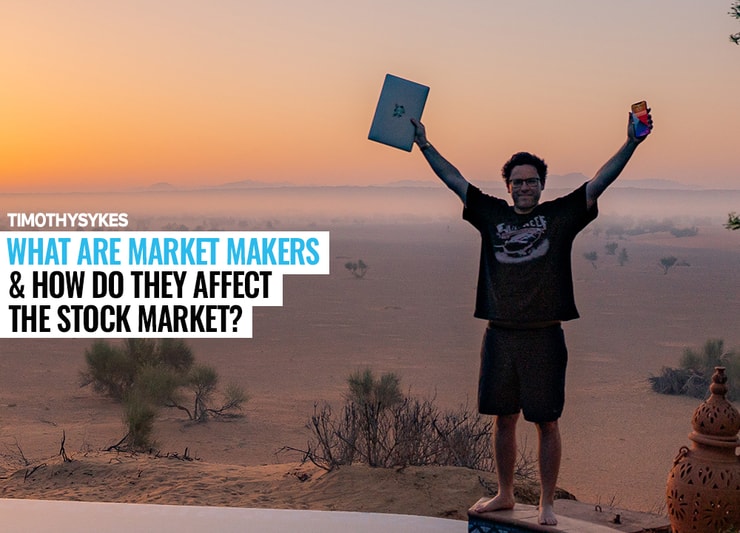Ever wondered who or what keeps the stock market running so smoothly? The answer: market makers.
Most traders don’t typically think about market makers. But understanding how they work is more important than you might think.
They do a lot to keep the stock market active. They’re often the reason our orders get filled as fast as they do.
Understanding what they do is part of learning how to be a self-sufficient trader.
I’ve even heard market makers say the best thing new traders can do is focus on how market makers operate and manipulate the stock market. Read on to find out if you agree…
(Listen to the SteadyTrade podcast crew talk with a former market maker here — it’s enlightening.)
Table of Contents
What Are Market Makers?

Market makers, aka liquidity providers, can be a firm or individual that gives traders and investors the ability to trade.
It’s more common for a market maker to be a brokerage house rather than an individual. That’s because of the size of securities needed to manage trades.
There are also specialized market makers known as designated primary market makers (DPM). They’re approved by an exchange and guarantee they’ll take a position in a specific security.
But the best way to understand what they are is to understand what they do.
What Does a Market Maker Do?
They consistently quote two-sided markets by giving bids and asks for a certain security. This helps bring liquidity into the stock market and allow for smooth transitions into and out of positions.
Think of it this way … Without liquidity providers, it wouldn’t be easy for traders or investors to exit positions due to a lack of buyers in the market.
Liquidity providers help keep the market active. When you want to buy a stock, they have some available to you. If you want to sell, they’ll buy it back.
But there’s a caveat…
They only buy and sell if the trader’s willing to settle on a specific price. They’re in this for the money too. They’re the makers of the market. They largely control the supply and demand in the stock market. And supply and demand is the reason the market moves the way it does.
As a trader, it’s so important to study up on market makers. If you understand what they do and the power they hold in the stock market, you can use them to your advantage instead of your downfall.
Do Market Makers Still Exist?
Yep, they still exist. If they didn’t, the markets wouldn’t be near as liquid as they are.
I don’t think liquidity providers will ever go away. Especially with the insane volatility we’ve seen in the past year or so. No matter your opinion on liquidity providers, we need them. It’d be near impossible to find trading consistency without them — there wouldn’t be any trading patterns.
If you want to learn about some of the patterns I’ve found consistency with, check out “The Complete Penny Stock Course” written by my student Jamil. It compiles all of my favorite patterns in one place and teaches you how to take advantage of them.
How Market Makers Make Profits

In short, they manage the bid-ask spread, which is how they make their profits.
The bid-ask spread is the difference between the asking price and the offering price of a security. It’s the difference between the highest price someone is willing to pay for a stock and the lowest price the seller will sell it for.
For example, when you look for the spread of a specific stock, you might see a bid price of $10 and an ask price of $10.03. That means the liquidity provider is buying the stock for $10 a share and selling it for $10.03.
Now that may not seem like much, but with high-volume trading, the small spread amounts to large profits for the liquidity providers.
You may not be a liquidity provider, but I think you can focus on profiting from your trades in a similar way — by aiming for singles instead of home runs. Singles can add up and if you manage your risk, you can grow your account over time.
In my 20+ years of day trading, I’ve found that taking singles is a great way to find consistency in your trading.* If you get caught up in the get-rich-quick mindset, the stock market can humble you FAST.
What’s the Difference Between Market Makers and Brokers?
Market makers are commonly brokerages that provide trading services for investors and traders, but that’s not always the case.
There’s a difference between the two when it comes down to the nitty-gritty.
Brokers are intermediates with the authorization to buy securities on behalf of an investor or trader. They’re licensed professionals who have the obligation to act in their client’s best interests.
Market makers, on the other hand, give liquidity to the markets. They keep the market active because they buy and sell stocks when others aren’t willing to do so.
However, sometimes a market maker is also a broker, which gives them an incentive to recommend stocks that they buy and sell. So do your due diligence and make sure you aren’t being manipulated by your broker … who could also be a market maker.
Do Market Makers Manipulate Stocks?

Yes, there are a few ways they could manipulate stocks to get what they want.
One way they might manipulate stocks is by posting fake sizes to lure traders and investors into buying or selling a stock.
For example, they could post a big size in a stock. That could make traders think that the stock has a high demand and will push higher. But in reality, it’s just tricking traders into buying a stock for more than it’s worth.
Another means of manipulation is screwing traders over in their market orders. When you place a market order, market makers could fill your order at the highest price possible. Remember, they want to make as much as they can on your trade.
That’s why I don’t use market orders. I don’t like to leave anything up to chance.
Now, let’s go over some ways that you can use market maker manipulation to profit, so you don’t have to leave anything up to chance either…
How Traders Use Market Makers Manipulation to Profit
The most effective way that I’ve learned to profit from market-maker manipulation is to ride the momentum that comes from it.
For example, if a market maker posts big sizes to make traders think there’s a lot of demand for a specific stock, you could potentially use that to your advantage. When more and more traders fall for the ploy and buy in, it will briefly push the stock higher.
Your job is to get in and out before the stock starts to fall.
You may only make a few dollars on the trade, but even a small win is still a win.
One of the biggest mistakes newbies make is that they’re too stubborn to take small gains. But guess what? I’ve made over $7.1 million from trading penny stocks by taking small gains.* I didn’t make it all at once. And you won’t either.
To me, true success in the stock market isn’t the ability to make millions on one trade, it’s learning how to become a self-sufficient trader and adapting to the market as it is. That’s how you can stay in the game. How bad do you want it?
Who Are the Biggest Market Makers?
GTS is the largest designated market maker (DMM) at the New York Stock Exchange. They manage nearly $12.5 trillion in market capitalization.
Some of the other big-name liquidity providers are BNP Paribas, Deutsche Bank, Morgan Stanley, and UBS.
You’ve probably heard some of these names before … They’re also brokerages that offer financial advisory services for recommending stocks and other securities. That’s part of how they will make money.
It’s also part of why I like to be real in an industry full of fakes. I know there are countless ‘gurus’ out there. And so many try to convince you to buy their alerts so they can capitalize from it.
But they don’t care if you’re successful or not. They just want to make money.
I want my students to learn to think for themselves. It’s why I created the Trading Challenge. I think it gives you the best chance of learning trading techniques that will help you become a self-sufficient trader. Apply for the Trading Challenge today if you’re ready to push yourself to be a better trader.
Now, let’s go over how to become a market maker…
How Do I Become a Market Maker?

Becoming a market maker isn’t an easy task. It’s a time-consuming process. I’ll tell you the basic steps, but it’s not my expertise. Want to be certified, look for professional assistance if that’s your thing.
Here are the steps:
- Complete the registration form.
- Have your clearing agency contact the National Securities Clearing Corporation (NSCC) to confirm a clearing arrangement.
- Call the FINRA district office so they can check whether you qualify.
- If you qualify, the FINRA district office will send approval to Nasdaq’s Subscriber Services Department.
- A representative will then contact you for final steps.
The process seems a little too complex for me. I’ll just stick with my penny stock niche.
Market Makers: The Bottom Line
Market makers, or liquidity providers, consistently quote two-sided markets and give bids and asks for specific securities. They help keep the stock market active.
They’re always ready to sell stock and buy it back as long as you’re willing to settle on the price they’re offering.
But they aren’t just there to make trading smooth. Remember, they want to make money too. And because of that, they can manipulate the markets to profit as much as possible.
That’s why it’s crucial to study how they operate. Learn how to take advantage of their manipulation instead of losing your hard-earned cash because of it.
Even though traders don’t typically study the ins and outs of market makers, it’s a big factor in helping you reach your goal of becoming a self-sufficient trader.
What do you think? Do you think about market makers while you trade? Let me know in the comments…
Disclaimers
*This level of successful trading is not typical and does not reflect the experience of the majority of individuals using the services and products offered on this website. From January 1, 2020, to December 31, 2020, typical users of the products and services offered by this website reported earning, on average, an estimated $49.91 in profit. This figure is taken from tracking user accounts on Profit.ly, a trading community platform. Timothy Sykes has a minority shareholder interest in the platform.








Leave a reply